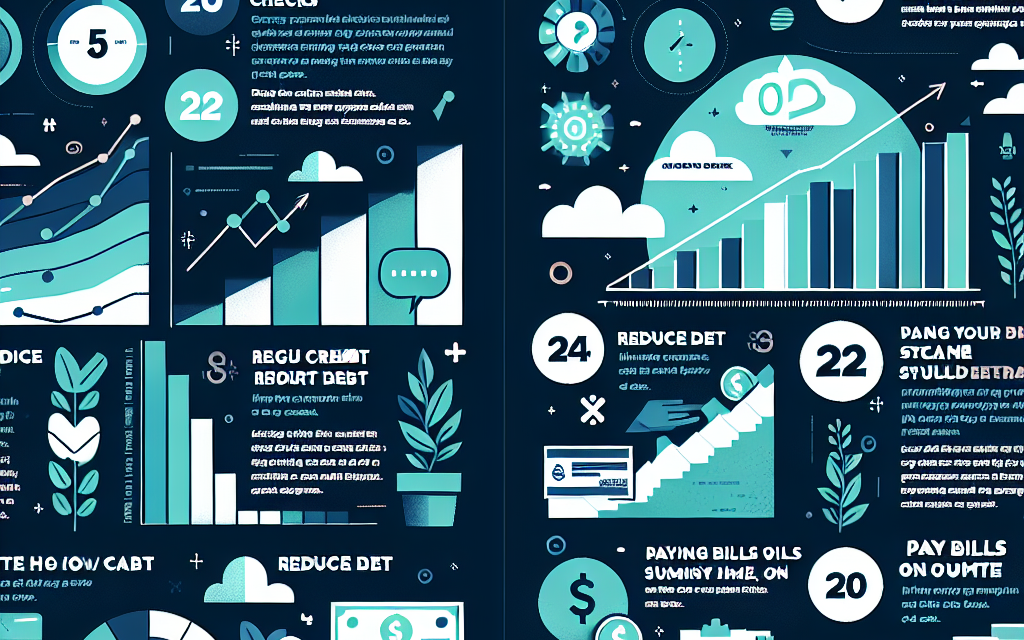“Elevate Your Financial Future: 10 Proven Strategies to Boost Your Credit Score in 2025!”
Introduction
In 2025, maintaining a strong credit score is more important than ever, as it influences everything from loan approvals to interest rates. With the evolving financial landscape and increasing reliance on credit for major purchases, understanding effective strategies to enhance your credit score is crucial. This guide outlines ten actionable strategies that can help you improve your creditworthiness, ensuring you are well-prepared to navigate the financial challenges and opportunities of the year ahead. By implementing these techniques, you can take control of your financial future and achieve your goals with confidence.
Understanding Credit Scores: The Basics
Understanding credit scores is essential for anyone looking to improve their financial health, particularly as we approach 2025, a year that promises to bring new challenges and opportunities in the realm of personal finance. A credit score is a numerical representation of an individual’s creditworthiness, typically ranging from 300 to 850. This score is derived from various factors, including payment history, credit utilization, length of credit history, types of credit in use, and recent credit inquiries. Each of these components plays a crucial role in determining how lenders perceive an individual’s ability to repay borrowed funds.
To begin with, payment history is the most significant factor influencing credit scores, accounting for approximately 35% of the total score. Timely payments on credit cards, loans, and other financial obligations demonstrate reliability and responsibility to potential lenders. Conversely, late payments, defaults, or bankruptcies can severely damage one’s credit score. Therefore, establishing a habit of making payments on time is fundamental for anyone aiming to enhance their credit profile.
Following payment history, credit utilization is another critical aspect, representing about 30% of the credit score calculation. This metric measures the ratio of current credit card balances to the total available credit limit. A lower utilization ratio indicates that an individual is not overly reliant on credit, which is viewed favorably by lenders. Ideally, keeping this ratio below 30% is recommended, as it signals financial discipline and the ability to manage credit responsibly.
Moreover, the length of credit history contributes approximately 15% to the overall score. A longer credit history provides lenders with more data to assess an individual’s credit behavior. Therefore, maintaining older credit accounts, even if they are not frequently used, can positively impact the length of credit history. This strategy underscores the importance of not closing old accounts, as doing so can inadvertently shorten one’s credit history and potentially lower the credit score.
In addition to these factors, the types of credit in use account for about 10% of the credit score. A diverse mix of credit, including revolving credit (like credit cards) and installment loans (such as mortgages or auto loans), can enhance one’s credit profile. Lenders often prefer applicants who can manage different types of credit responsibly, as it indicates a broader experience with financial products.
Lastly, recent credit inquiries, which make up about 10% of the score, reflect how often an individual has applied for new credit. While a few inquiries may not significantly impact the score, multiple inquiries within a short period can raise red flags for lenders, suggesting potential financial distress. Therefore, it is advisable to limit new credit applications and to space them out over time.
In conclusion, understanding the fundamentals of credit scores is vital for anyone looking to improve their financial standing in 2025. By focusing on timely payments, maintaining a low credit utilization ratio, preserving older accounts, diversifying credit types, and managing inquiries judiciously, individuals can take significant steps toward boosting their credit scores. As the financial landscape continues to evolve, being informed about these basic principles will empower consumers to make sound financial decisions and achieve their long-term financial goals.
Timely Payments: The Key to a Healthy Score
Timely payments are undeniably the cornerstone of a healthy credit score, serving as a critical factor in determining an individual’s creditworthiness. In 2025, as the financial landscape continues to evolve, understanding the importance of making payments on time becomes increasingly essential for anyone looking to improve their credit score. Payment history accounts for approximately 35% of a credit score, making it the most significant component. Therefore, establishing a consistent pattern of timely payments can yield substantial benefits.
To begin with, it is crucial to recognize that even a single missed payment can have a lasting impact on your credit score. When payments are late, creditors report this information to credit bureaus, which can lead to a decrease in your score. Consequently, it is advisable to set up reminders or alerts for upcoming due dates. Many financial institutions offer tools that allow customers to receive notifications via email or text, ensuring that they remain aware of their obligations. By utilizing these resources, individuals can significantly reduce the risk of late payments.
Moreover, automating payments can serve as an effective strategy for maintaining timely payments. By enrolling in automatic payment plans, individuals can ensure that their bills are paid on time without the need for manual intervention. This approach not only helps in avoiding late fees but also contributes positively to one’s credit history. However, it is essential to monitor bank accounts regularly to ensure that sufficient funds are available to cover these automated payments, as overdrafts can lead to additional fees and complications.
In addition to automation, creating a budget can further enhance one’s ability to make timely payments. By outlining income and expenses, individuals can gain a clearer understanding of their financial situation, allowing them to allocate funds appropriately for bills. This proactive approach not only aids in avoiding late payments but also fosters better financial habits overall. As individuals become more attuned to their spending patterns, they may find it easier to prioritize essential payments, thereby safeguarding their credit scores.
Furthermore, it is important to consider the impact of credit utilization on timely payments. While this factor primarily relates to how much credit is being used compared to the total available credit, maintaining low balances can facilitate easier management of payments. By keeping credit card balances low, individuals can ensure that they are not overwhelmed by high monthly payments, making it easier to pay on time. This strategy not only supports timely payments but also contributes positively to the overall credit score.
Additionally, individuals should regularly review their credit reports for any inaccuracies that may affect their payment history. Errors in reporting can lead to unjust penalties on one’s credit score. By obtaining free credit reports from the major credit bureaus, individuals can identify and dispute any discrepancies, ensuring that their payment history accurately reflects their financial behavior.
In conclusion, timely payments are fundamental to achieving and maintaining a healthy credit score. By implementing strategies such as setting reminders, automating payments, creating a budget, managing credit utilization, and reviewing credit reports, individuals can significantly enhance their ability to make payments on time. As the financial landscape continues to change, prioritizing timely payments will remain a vital component of effective credit management, ultimately leading to improved credit scores and greater financial opportunities.
Credit Utilization: How to Manage Your Debt
Credit utilization is a critical factor in determining your credit score, and understanding how to manage it effectively can significantly enhance your financial health. Essentially, credit utilization refers to the ratio of your current credit card balances to your total available credit limits. This ratio is a key component of your credit score, accounting for approximately 30% of the overall calculation. Therefore, managing this aspect of your credit profile is essential for anyone looking to boost their score in 2025.
To begin with, it is advisable to keep your credit utilization ratio below 30%. This means that if you have a total credit limit of $10,000, you should aim to maintain a balance of no more than $3,000 across all your credit cards. By adhering to this guideline, you signal to lenders that you are responsible with your credit, which can positively influence your credit score. However, for those who are particularly ambitious about improving their score, striving for a utilization rate below 10% can yield even better results.
In addition to maintaining a low utilization ratio, it is also beneficial to pay down existing debt. Reducing your outstanding balances not only lowers your utilization ratio but also demonstrates to creditors that you are actively managing your financial obligations. This proactive approach can lead to an increase in your credit score over time. Moreover, consider making multiple payments throughout the month rather than waiting until the due date. By doing so, you can keep your balances lower and further improve your utilization ratio.
Another effective strategy is to request a credit limit increase. When your credit limit increases while your balances remain the same, your utilization ratio automatically decreases. However, it is crucial to approach this option with caution. If you choose to increase your spending in tandem with a higher limit, you may inadvertently negate the benefits of the increased limit. Therefore, it is essential to maintain disciplined spending habits to truly capitalize on this strategy.
Furthermore, it is wise to avoid closing old credit accounts, even if they are no longer in use. The length of your credit history plays a role in your credit score, and closing an old account can shorten this history, potentially lowering your score. Instead, consider keeping these accounts open and using them occasionally for small purchases, which can help maintain your credit utilization ratio while also keeping your credit history intact.
Additionally, monitoring your credit report regularly can provide valuable insights into your credit utilization and overall credit health. By reviewing your report, you can identify any discrepancies or errors that may be negatively impacting your score. If you find inaccuracies, it is essential to dispute them promptly to ensure your credit report reflects your true financial situation.
Lastly, it is important to remember that managing credit utilization is not a one-time effort but rather an ongoing process. By consistently applying these strategies, you can cultivate a healthy credit profile that not only boosts your score but also positions you favorably for future financial opportunities. As you navigate the complexities of credit management, remain mindful of your spending habits and strive for a balanced approach to debt. In doing so, you will be well on your way to achieving a stronger credit score in 2025 and beyond.
The Importance of Credit Mix: Diversifying Your Accounts
A healthy credit score is a crucial component of financial well-being, influencing everything from loan approvals to interest rates. One of the often-overlooked factors that contribute to a robust credit score is the diversity of one’s credit mix. Credit mix refers to the variety of credit accounts you hold, including credit cards, installment loans, mortgages, and retail accounts. Understanding the importance of credit mix can empower individuals to make informed decisions that enhance their credit profiles.
To begin with, a diverse credit mix demonstrates to lenders that you can manage different types of credit responsibly. When you have a combination of revolving credit, such as credit cards, and installment loans, like personal or auto loans, it signals your ability to handle various financial obligations. This versatility can positively impact your credit score, as scoring models, such as those developed by FICO and VantageScore, often reward consumers who exhibit a well-rounded credit history. Therefore, if you currently rely solely on credit cards or only have installment loans, it may be beneficial to consider adding different types of credit to your portfolio.
Moreover, maintaining a healthy credit mix can also mitigate the risks associated with relying on a single type of credit. For instance, if you only have credit cards and face unexpected financial challenges, such as job loss or medical expenses, you may find it difficult to manage your debt effectively. Conversely, having a mix of credit types can provide a buffer, allowing you to navigate financial difficulties more smoothly. This resilience is particularly important in today’s unpredictable economic climate, where financial stability can be fleeting.
In addition to enhancing your credit score, a diverse credit mix can also improve your overall financial literacy. Engaging with different types of credit requires you to understand various terms, interest rates, and repayment structures. This knowledge not only equips you to make better financial decisions but also fosters a sense of responsibility and discipline in managing your finances. As you become more adept at handling different credit accounts, you may find yourself more confident in your ability to make sound financial choices.
Furthermore, it is essential to approach the diversification of your credit mix strategically. Opening new credit accounts indiscriminately can lead to hard inquiries on your credit report, which may temporarily lower your score. Instead, consider your current financial situation and future goals. For example, if you are planning to purchase a home in the near future, it may be wise to focus on establishing a mortgage or a home equity line of credit. On the other hand, if you are looking to improve your day-to-day cash flow, adding a personal loan or a credit card with rewards may be more beneficial.
In conclusion, diversifying your credit accounts is a vital strategy for boosting your credit score in 2025. By understanding the significance of credit mix and its impact on your overall financial health, you can take proactive steps to enhance your credit profile. As you explore different types of credit, remember to do so thoughtfully and strategically, ensuring that each new account aligns with your financial goals. Ultimately, a well-rounded credit mix not only contributes to a higher credit score but also fosters greater financial resilience and literacy, paving the way for a more secure financial future.
Regularly Checking Your Credit Report: Spotting Errors
Regularly checking your credit report is a fundamental strategy for anyone looking to boost their credit score in 2025. This practice not only helps you stay informed about your credit status but also enables you to identify and rectify any inaccuracies that may be negatively impacting your score. Credit reports, which are compiled by major credit bureaus, contain detailed information about your credit history, including your payment history, credit utilization, and any public records such as bankruptcies or liens. Given the significant role that credit scores play in financial decisions, from securing loans to obtaining favorable interest rates, it is crucial to ensure that the information contained in your report is accurate.
To begin with, it is essential to understand that errors in credit reports are not uncommon. In fact, studies have shown that a substantial percentage of consumers have found inaccuracies in their reports. These errors can arise from various sources, including clerical mistakes, outdated information, or even identity theft. Therefore, by regularly reviewing your credit report, you can spot these discrepancies early on and take the necessary steps to correct them. This proactive approach not only helps maintain the integrity of your credit history but also prevents potential long-term damage to your credit score.
When checking your credit report, it is advisable to look for specific types of errors. For instance, you should verify that all accounts listed are yours and that the information regarding payment history is accurate. Late payments, if reported incorrectly, can significantly lower your score. Additionally, ensure that your credit utilization ratio is correctly calculated. This ratio, which compares your total credit card balances to your total credit limits, is a critical factor in determining your credit score. If your report inaccurately reflects high balances or limits, it could unfairly penalize you.
Moreover, it is important to check for any accounts that may have been opened in your name without your consent. Identity theft can have devastating effects on your credit score, and early detection is key to mitigating the damage. If you notice unfamiliar accounts, it is crucial to take immediate action by reporting the fraud to the credit bureau and the relevant financial institutions. This not only helps protect your credit score but also safeguards your financial identity.
In addition to identifying errors, regularly checking your credit report allows you to monitor your overall credit health. By keeping track of your score and understanding the factors that influence it, you can make informed decisions about your financial behavior. For example, if you notice a decline in your score, you can investigate the reasons behind it and adjust your spending or payment habits accordingly. This ongoing awareness fosters a sense of responsibility and encourages better financial practices.
Furthermore, many credit bureaus offer free access to your credit report at least once a year, which provides an excellent opportunity to review your information without incurring any costs. Taking advantage of these resources can empower you to take control of your credit journey. In conclusion, regularly checking your credit report is an indispensable strategy for boosting your credit score in 2025. By spotting errors and addressing them promptly, you not only protect your financial reputation but also pave the way for better credit opportunities in the future. As you embark on this journey, remember that vigilance and proactive management are key to achieving and maintaining a healthy credit score.
Becoming an Authorized User: Leveraging Someone Else’s Credit
Becoming an authorized user on someone else’s credit account can be a strategic move to enhance your credit score, particularly in 2025, when credit scores play a pivotal role in financial decisions. This approach allows you to benefit from the primary account holder’s credit history without being responsible for the debt. To begin, it is essential to choose the right person to add you as an authorized user. Ideally, this should be someone with a strong credit history, low credit utilization, and a consistent record of on-time payments. By aligning yourself with a responsible credit user, you can potentially inherit their positive credit behaviors, which can significantly impact your credit score.
Once you have identified a suitable primary account holder, it is crucial to communicate openly about the arrangement. Discussing expectations and responsibilities can help prevent misunderstandings. For instance, while you will not be responsible for making payments, it is wise to ensure that the primary account holder understands the importance of maintaining their good credit habits. This mutual understanding can foster a healthy financial relationship and ensure that both parties benefit from the arrangement.
After being added as an authorized user, it is important to monitor your credit report closely. This step is vital because not all credit card issuers report authorized user activity to the credit bureaus. Therefore, verifying that the account appears on your credit report is essential to ensure that you are receiving the intended benefits. You can obtain a free credit report from each of the three major credit bureaus annually, allowing you to track changes and improvements in your credit score.
In addition to monitoring your credit report, it is beneficial to understand how credit utilization affects your score. Credit utilization refers to the ratio of your current credit card balances to your total credit limits. A lower utilization rate is generally favorable, as it indicates to lenders that you are not overly reliant on credit. By becoming an authorized user on an account with a low utilization rate, you can improve your overall credit utilization, which can lead to a higher credit score.
Furthermore, it is essential to maintain a long-term perspective when leveraging someone else’s credit. While becoming an authorized user can provide immediate benefits, the most significant improvements in your credit score will take time. Consistently demonstrating responsible credit behavior, such as making timely payments on your own accounts and keeping your credit utilization low, will complement the positive impact of being an authorized user.
Moreover, it is wise to diversify your credit mix. While being an authorized user can enhance your credit score, having a variety of credit types—such as installment loans, credit cards, and retail accounts—can further strengthen your credit profile. This diversification signals to lenders that you can manage different types of credit responsibly.
In conclusion, becoming an authorized user is a powerful strategy to boost your credit score in 2025. By selecting the right primary account holder, maintaining open communication, and monitoring your credit report, you can effectively leverage someone else’s credit history to your advantage. Coupled with responsible credit practices and a focus on credit utilization and diversification, this strategy can pave the way for improved financial opportunities and a healthier credit profile. As you navigate the complexities of credit management, remember that patience and diligence are key to achieving your credit goals.
The Impact of New Credit Inquiries: What You Need to Know
When it comes to managing your credit score, understanding the impact of new credit inquiries is crucial. Credit inquiries occur when a lender checks your credit report to assess your creditworthiness, and they can be categorized into two types: hard inquiries and soft inquiries. Hard inquiries, which typically happen when you apply for a new credit card, loan, or mortgage, can have a more significant effect on your credit score. In contrast, soft inquiries, such as those conducted for pre-approval offers or personal credit checks, do not impact your score.
The significance of hard inquiries lies in their potential to signal risk to lenders. When you apply for multiple credit accounts in a short period, it may suggest that you are experiencing financial distress or are overextending yourself. Consequently, this can lead to a temporary dip in your credit score, which may last for several months. Therefore, it is essential to be strategic about when and how often you apply for new credit.
Moreover, the impact of hard inquiries on your credit score diminishes over time. Typically, a hard inquiry will remain on your credit report for two years, but its effect on your score will lessen significantly after the first year. This means that if you are planning to make a significant financial decision, such as applying for a mortgage, it is wise to limit new credit applications in the months leading up to that decision. By doing so, you can minimize the number of hard inquiries on your report and present a more favorable credit profile to potential lenders.
In addition to timing your credit applications, it is also beneficial to understand the concept of rate shopping. When you are in the market for a loan, such as a mortgage or an auto loan, multiple inquiries within a short period—typically 14 to 45 days—are often treated as a single inquiry by credit scoring models. This means that if you are diligent about comparing rates, you can minimize the negative impact on your credit score while still finding the best deal.
Furthermore, it is essential to monitor your credit report regularly. By keeping an eye on your credit report, you can identify any unauthorized inquiries or errors that may be affecting your score. If you notice any discrepancies, you have the right to dispute them with the credit reporting agency. This proactive approach not only helps maintain your credit score but also ensures that your credit history accurately reflects your financial behavior.
In conclusion, understanding the impact of new credit inquiries is vital for anyone looking to boost their credit score in 2025. By being mindful of the types of inquiries, timing your applications strategically, and taking advantage of rate shopping, you can mitigate the negative effects of hard inquiries. Additionally, regular monitoring of your credit report allows you to stay informed and take corrective action when necessary. Ultimately, a well-informed approach to managing credit inquiries can lead to a healthier credit score and better financial opportunities in the future. As you navigate the complexities of credit management, remember that each decision you make can have lasting implications for your financial health.
Q&A
1. **What is one effective way to improve your credit score?**
Pay your bills on time consistently.
2. **How does credit utilization affect your credit score?**
Keeping your credit utilization below 30% can positively impact your score.
3. **Why is it important to check your credit report regularly?**
Regular checks help identify errors or fraudulent activity that can harm your score.
4. **What role do credit accounts play in your credit score?**
Having a mix of credit accounts (credit cards, loans) can enhance your score.
5. **How can becoming an authorized user help your credit score?**
It allows you to benefit from the primary account holder’s positive credit history.
6. **What is the impact of closing old credit accounts?**
Closing old accounts can reduce your credit history length, potentially lowering your score.
7. **How can limiting new credit inquiries help your credit score?**
Reducing the number of hard inquiries can prevent a temporary dip in your score.
Conclusion
In conclusion, implementing these 10 strategies—such as consistently paying bills on time, reducing credit card balances, diversifying credit types, regularly checking credit reports for errors, and limiting new credit inquiries—can significantly enhance your credit score in 2025. By adopting responsible credit habits and staying informed about credit management, individuals can achieve better financial opportunities and lower interest rates, ultimately leading to improved financial health.





